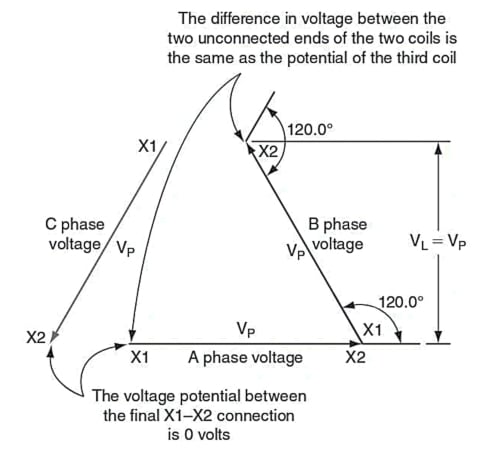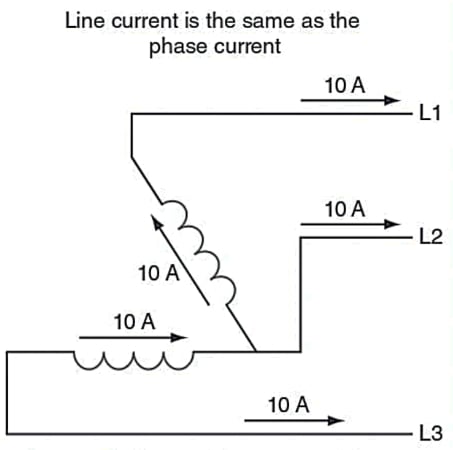Using Open Deltas Strategically To Increase Transformer Capacity
Open delta transformers allow delta-connected transformers to supply three-phase loads with two-phase windings while maintaining phase voltages. However, this reduces power capacity by approximately 57.8% compared to traditional three-phase delta transformers, requiring careful load planning.
Open delta transformers allow delta-connected transformers to supply three-phase loads using two-phase windings while preserving phase voltages. However, this approach reduces power capacity, approximately 57.8% of a standard three-phase delta transformer. This limitation requires careful load planning and consideration, particularly in utility applications. Open delta connections can be strategically employed by utilities, initially providing power with two transformers and then expanding capacity by incorporating a third transformer, ultimately increasing the total capacity by 173%.

Imaged used courtesy of Adobe Stock
A special characteristic of the delta-connected transformer allows it to supply three-phase loads using only two-phase windings. This is called the open delta. The potential difference between the final connection points of the phase windings in a delta system should be nearly 0 V. For this to be true, the potential difference between the beginning of the first coil and the end of the second coil after they have been connected must equal the phase voltage of the third coil. Figure 1 illustrates a typical delta transformer connection.


Figure 1. A delta transformer showing line voltage potentials and vector representations of phase voltages. Imaged used courtesy of Ahmed Sheikh
Each of the phase voltages is the same as the line voltages. If one of the phase windings were removed, the potential between the points of the remaining phase windings connected to the line voltage leads does not change. The potential between the final connection points of the phase windings in a delta system is 0 V because there is a voltage potential between the unconnected ends of the two-phase windings equal to the phase voltage of the third winding. Once the third winding is added, that potential difference is canceled.
If the delta system has only two-phase windings, the potential difference between the three-line conductors will still be the same as if there were three-phase windings. Therefore, if one winding of a three-phase delta transformer secondary should fail, if one of the primary windings of a three-phase delta transformer should fail, or if one of the fuses to the transformer primary should open, there will still be a three-phase secondary voltage.
Tech Tip
Two-phase windings in an open delta result in the same line voltages as three windings.
Line Current in the Open Delta
There are only two-phase windings in the open delta connection, so the amount of power available is less than in the normal delta, which has three-phase windings. The total available power, however, is not one-third less, as you might imagine, because of the way current flows in a delta system. The drawing in Figure 2A shows that the line current flows from two windings in a normal delta system: IL = IP x 1.73. In the open delta shown in Figure 2B, L1 and L2 conductors are each connected to only one phase winding.
The current that can be supplied to these two-line conductors cannot be more than the phase current of one phase winding; therefore, in the open delta, IL = IP, which is 57.8% of the line current in a normal delta transformer.

Figure A. Line and phase current in a normal delta-connected transformer with three windings

Figure B. Line and phase current in an open delta-connected transformer with two windings
Figure 2 (A and B). A delta transformer line current with three windings and two windings. Imaged used courtesy of Ahmed Sheikh
Power in the Open Delta
The power of the three-phase transformer is still VL x IL x 1.73. The line current equals the phase current (IL ÷ 1.73); therefore, the total power will be (IL ÷ 1.73) x VL x 1.73, or 57.8% of the power in a normal delta transformer with three windings.
Tech Tip
Power in the open delta is 57.8% of the three-phase power available with three windings.
Example
If one winding of a three-phase delta transformer fails, the transformer will still provide three-phase voltage, but it can supply only about 58% of the load that the three windings could supply in a three-phase delta transformer.
A 150 KVA three-phase wye/delta transformer supplies a load of 130 KVA. One winding of the transformer primary has failed. As a result, there is no voltage induced in one of the secondary delta windings. How much load must be turned off to prevent the remaining two secondary windings from being overloaded?
Because the original transformer capacity is 150 KVA, the remaining two 50 KVA windings in an open delta can supply only 150 KVA x 57.8% = 86.7 KVA. Because the original load was 130 KVA, 130 KVA – 86.7 KVA = 43.3 KVA, that must be turned off.
Utilities can use the open delta connection to supply three-phase power with only two transformers; when the load increases, one more transformer can be added to form a three-phase delta bank. Using only two 50 KVA transformers, the three-phase load that can be supplied will be 86.7 KVA, as we saw in the previous example. When the load increases, adding one more 50 KVA transformer connected in a normal delta will give a total capacity of 150 KVA—an increase of 173%. The open delta connection will use 86.7% of the available capacity of the two 50 KVA transformers. To determine the capacity of each of the two transformers required to serve a three-phase load from an open delta transformer, divide the required KVA by 86.7%. This will give you the total KVA capacity required. Next, divide the result by 2 to find the size of each of the two transformers.
Tech tip
Power in the open delta is 86.7% of the two windings’ total available capacity.
Example
A three-phase load of 240 KVA is to be supplied by an open delta transformer bank so the utility can increase the capacity by 173% in the future by adding only one more single-phase transformer. What size will each of the two single-phase transformers have to be? What will be the total capacity if the third transformer is added?
The 240 KVA ÷ 86.7% = 276.8 KVA is the available capacity of the two single-phase transformers. Each transformer must be 276.8 ÷ 2 = 138.4 KVA.
When the third transformer is added, the total capacity is 138.4 x 3 = 415.2 KVA.
Open Delta Transformer Summary
Understanding open delta transformers is significant in power systems and utility management. It equips professionals with the knowledge to optimize power distribution and capacity while ensuring reliability. By comprehending the trade-offs and benefits of the open delta configuration, individuals can make informed decisions in load planning, enhancing power delivery efficiency and resilience. In a world with increasing power demands, harnessing the advantages of open delta transformers while mitigating the limitations is critical. This technical expertise enhances the effectiveness of electrical systems and plays a pivotal role in promoting sustainability and cost-effectiveness in power resource management.







As I understand it this isn’t a commonly used configuration as it typically implies that the transformer is made up of single phase subunits and it appears more common to deploy a transformer as a complete three-phase block.
Elsewhere I read that it could be used to provide redundancy on a critical service as a three-transformer group could be over-provisioned such that any one transformer could fail or be taken out of service without interrupting the supply. However a balancer would probably be needed which is itself a point of failure, making a pair of three-phase units deployed in parallel possibly the more attractive option.